The new Micron 9400 series is the company’s high-performance PCIe Gen4 NVMe SSD for data centers. Micron’s goal was simple: to create the fastest PCIe Gen4 NVMe SSD it could while also offering new, larger capacity points. At STH, we are testing 32TB class versions of this drive, so capacity points are increasing quickly.
Micron 9400 Launched as the Mega PCIe Gen4 Data Center NVMe SSD
The Micron 9400 is the company’s high-performance NVMe SSD for PCIe Gen4. Below these new drives in the stack are the mainstream Micron 7000 series and then the SATA Micron 5000 series. The Micron 7000 series was unique insofar as it covered an enormous range of form factors.
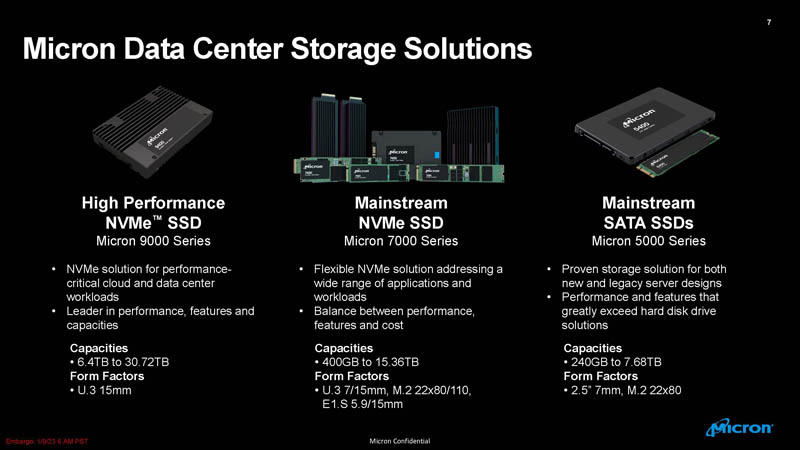
In terms of where this family fits, the 9400 series is positioned above the mainstream segment. For those wondering, on the “Enterprise Storage” segment, in Micron’s diagram, that is the often dual-port NVMe segment that is designed for storage arrays. This is more of the single-port high-performance drive family.
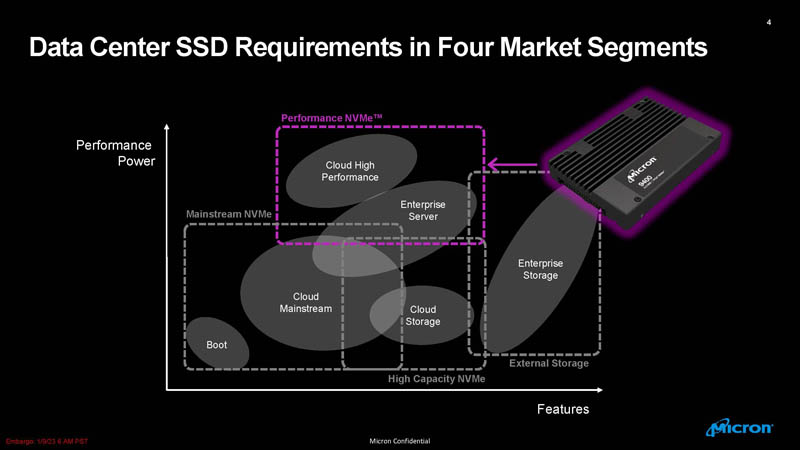
With the new Micron 9400 series, the company has transitioned it portfolio over to 176-layer NAND.
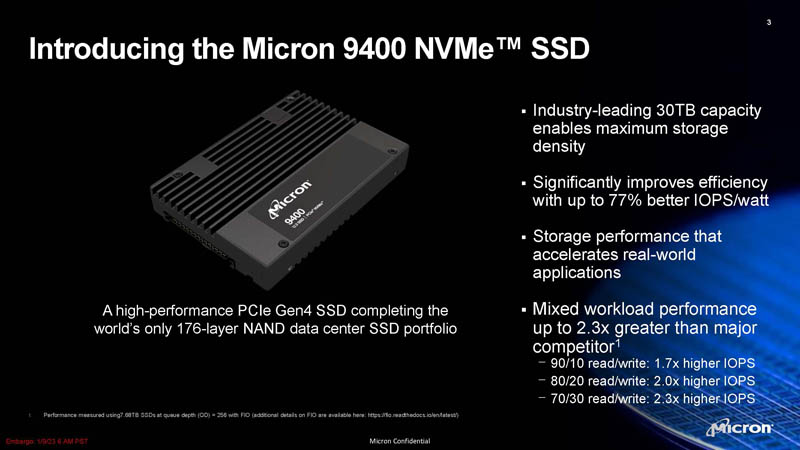
Another side of this drive is also just the capacity. The new drives are rated to 30.72TB in 1 DWPD configuration and 25.6TB in a 3 DWPD configuration. Writing more than 30TB/ day to a device seems less likely, so we asked about why there is a need for the 3 DWPD. We were told that was a market demand spec, but also, the random write and mixed performance is higher. One gives up ~17% of the drive’s capacity for an additional 83% random write performance.
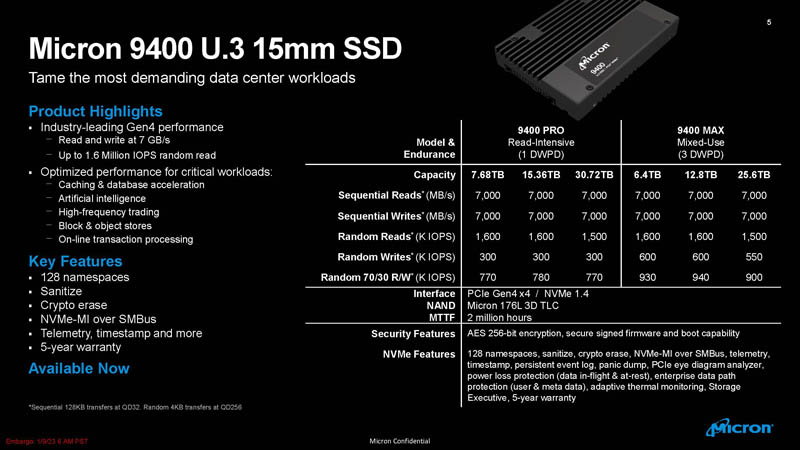
Micron told STH that it is starting to see more demand for the >15.36TB drives so that is an industry trend.
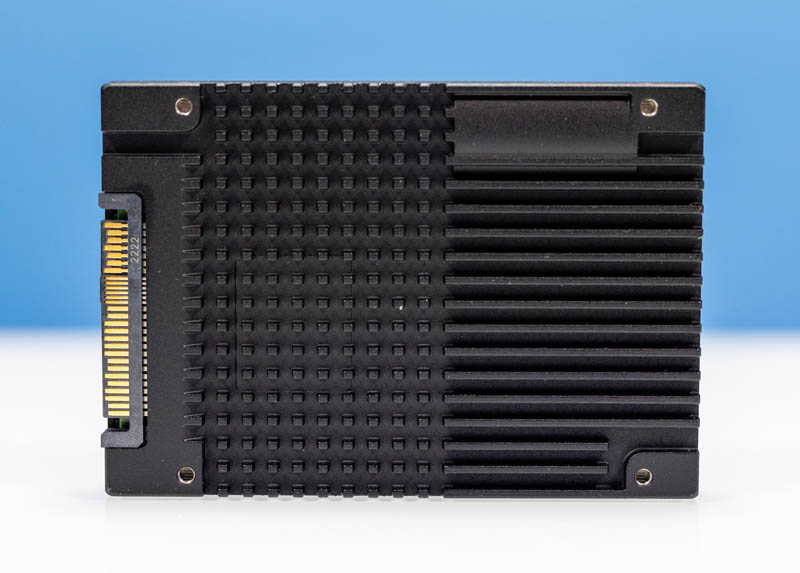
Another trend, and unfortunately, Micron did not share this view with STH, but the market in 2023 is likely going to be PCIe Gen3/ Gen4, with <10% Gen5. We asked why not a Gen5 drive, and the answer was that 2023 we should see PCIe Gen4 take over from Gen3 as the dominant drive interface, then PCIe Gen4 will dominate the market in 2024 and likely 2025 before PCIe Gen5 then starts to take over as we get PCIe Gen6 servers. That was an interesting observation.
Final Words
The Micron 9400 launch is perhaps at the strangest time for STH. It is happening roughly 28 hours before the 4th Generation Intel Xeon Scalable launch. We have been testing these drives for some time, but we are going to wait a week or so for our formal review for a simple reason: we wanted to show you the performance on every modern server. It seemed silly to release a review without the major new Intel Xeon platform this year, yet to use the AMD EPYC Genoa platform, so stay tuned for that. In the meantime, we wanted to cover the launch today.
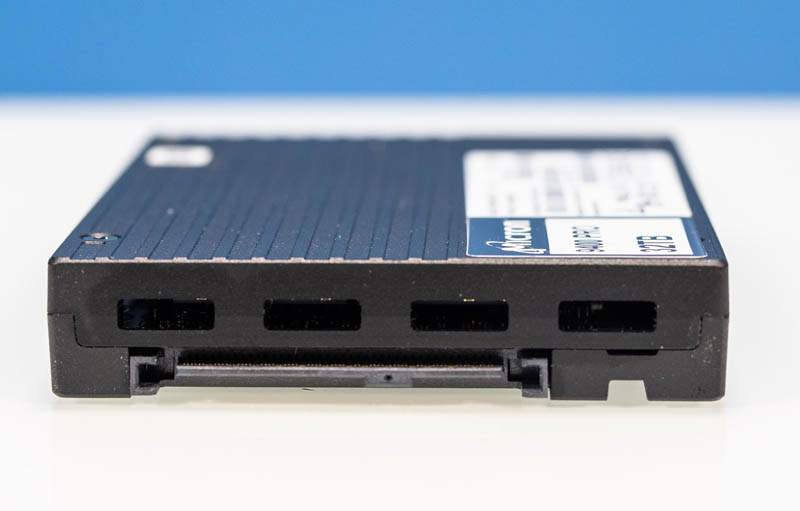

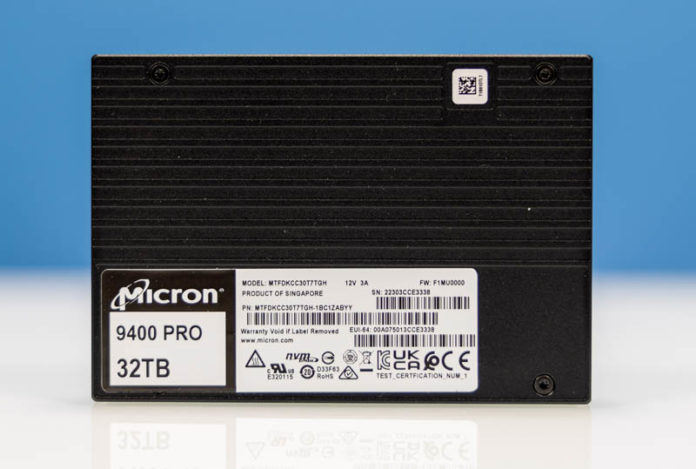



“why not a Gen5 drive, and the answer was that 2023 we should see PCIe Gen4 take over from Gen3 as the dominant drive interface, then PCIe Gen4 will dominate the market in 2024 and likely 2025 before PCIe Gen5 then starts to take over”
I suppose that’s an answer, but in my mind not a very good one. PCIe Gen5 is not exactly exotic at this point. Samsung’s datacenter-oriented 5.0 PM1743, for example, was announced over a year ago. The 5.0 Kioxia CD8 was nearly 9 months ago.
Sorry Micron – but I’m calling BS on your reason.
I assume this is TLC?
For large arrays speed is limited by network anyway. I’m more interested in PCIe5 x2 QLC drives for cost, capacity and using fewer lanes.
@Greg, could you please share details about your workload where Gen4 is the bottleneck, or is likely to be in the next 1-2 years? When you have, say, 12 drives (could easily be 24 in a 2U, I went for the middle) providing 84GB/s aggregate throughput, how do you use that much data?
Of course, it’s unlikely to always (if ever) hit the upper limits of the drives’ throughput but that is actually my point. I think Gen 5 is totally worthless for storage right now. Maybe if you use 2 lanes per drive to hook more drives? But I don’t know if any chassis offers that. And with Gen5 the signal integrity is a bigger problem.
Huge capacity SSDs with a great DWPD is great for CDN caching storage tier, where one constantly needs to swap in new data. Big plus if great random mixed performance.
@Nikolay – I would argue that’s irrelevant. Micron is releasing a new drive that’s gen 4 when many of their competitors serving the same market were announcing gen 5 drives a long time ago. When asked, they gave a reason that the market wasn’t going to be using gen 5 until 2024. Except, new 2023 platforms like Genoa and 4th gen Intel Xeon Scalable are absolutely gen 5, so that doesn’t really track.
Thus, their reason is suspicious enough to me to call BS. That’s the only point I’m making. I’m sure it’ll be a fine drive and will serve its intended workloads admirably – but again, that’s not the point.
In general though I have a solid distaste for the “we aren’t/can’t use it today so we shouldn’t bother” argument.
@Greg, I suggest we agree to disagree. Gen 5 adoption will be driven by other technologies where Gen4 is a bottleneck like CXL, 400/800Gb Ethernet (well, for 800Gb Ethernet even Gen5x16 is a bottleneck), accelerators, (GP)GPUs. Not by storage. Storage will move over to Gen5 when there is enough install base of Gen5 platforms and it provides tangible benefits that outwiegh its cost, or the cost penalty (due to more stringent signal quality requirements, power consumption, silicon cost) becomes negligible. Not when the techno enthusiasts like you and me want it. You cannot even get a Gen5 GPU today and the first ones will probably arrive only next year. I think Micron are totally on point here. Just my 2 cents.
“It seemed silly to release a review without the major new Intel Xeon platform this year, yet to use the AMD EPYC Genoa platform”
Just review them with any system. Milan and Ice Lake are good enough. It’s not like the IOPS are going to go through the roof with newer gen.
As a potential buyer I really just want to know how the write speed is for random writes for both empty and almost full drive. The MAX seems to have more overprovisioning so “full” drive shouldn’t be a problem but I want proof.
@Nikolay – Absolutely, we can agree to disagree on the value of gen 5 in this product. However, I still would suggest that Micron’s _stated reason_ for this particular product not being gen 5 is suspect. They may be completely on point re: adoption, but I just don’t believe them when they say that’s the reason this product is not gen 5.
@Greg, my final post in this matter. It turns out, the recently announced Sapphire Rapids CPUs from Intel will only do Gen4 when bifurcated down to x2 (which, as another poster before me suggested, could have been a use case for Gen5). So maybe Micron knew sth that we didin’t?
Cheers
@Greg – My read from the article is Micron does not see market demand for Gen5. This makes sense, as I suspect we hit diminishing returns. Engineering is not cheap, so you have to focus.
Remember, not so long ago, we were on SATA/SAS drives (and in large still are deployed). With 2x more throughput every few years, the fraction of applications that need that throughput is less.
Of course, there are always a few niche applications that can use all the throughput we can get, but over time that is going to be a steadily shrinking portion of the market.
These drives are kind of pointless for shared network storage. Put 16x of these drives in an array, and hard to get that throughput over the network. So you lose that fraction of the market. That leaves in-server storage.
One of these drives is roughly 32x a SATA drive. You could get 4x of these drives in a 1U without trying hard. So now you have a 1U server equivalent to 128x SATA drive server. How many of those have you seen deployed?
You really have to get to high-core-count CPUs and virtualization for these drives to make sense. Again, a fraction of the market.
Put differently, have you installed the maximum amount of RAM in all your computers? Likely not, as for most use we hit diminishing returns a long time ago. (Have to admit, giggled when I saw 32GB RAM was only $200 for a small/gateway box.)
@Preston – I don’t necessarily disagree with anything you’ve written. I’ve not once tried to make an appeal for gen 5 connectivity being necessary for these drives. My point was, and remains, that Micron’s *stated* reason is likely bunk. With their competitors having announced gen 5 in their products already (some over a year ago), my belief is that the only reason Micron wouldn’t add gen 5 to this product is because they ran into trouble and either didn’t have the time or resources to fix it.
Incidentally, as a point of fact, all servers I’ve ordered over the last 7 years were, in fact, fully maxed on RAM, and most of my personal PCs are not far off.
In any case, this will be my last response on this topic. I feel like everyone is ignoring my actual point and instead trying to argue the straw-man that gen 5 isn’t needed. I agree–it probably isn’t–but that’s never been the point I’ve been trying to make.